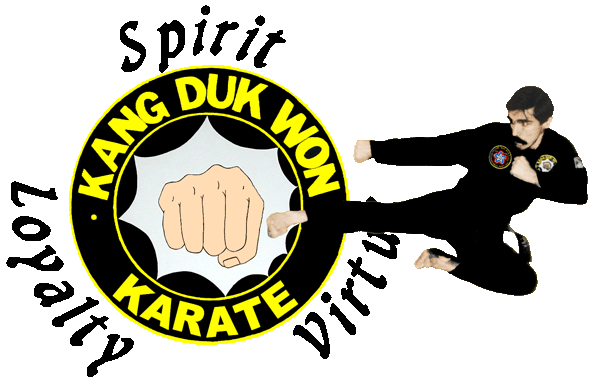
 |
AMERICAN KANG DUK WON KARATE |
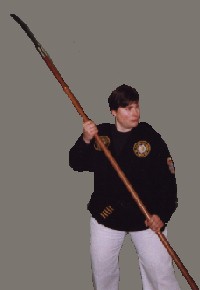 |
To Master Lawlor, Thank you for the challenge. Your student always, Debby Hintopoulos
Naginata: The Curved Spear from Japan's Past to Contemporary Times.............3 Footnotes......................................................................6 Happo Buri (warmup exercises)..................................................7 Kamae (combative engagement posture, position, guard)..........................8 Tai Sabaki (footwork).........................................................10 Uchi(strike)..................................................................11 Naginata Form: P'okp'ung Nun (Storm's Eye)....................................12 P'okp'ung Nun-Form Pattern....................................................15
In feudal times the use of the naginata was known as naginata-jutsu, the "art of the naginata" and was part of Bujutsu, the classical Japanese military arts. Today its use is called naginata-do, the "way of the naginata", and is part of Budo.(1)
This information isn't entirely accurate. Today both naginata-do and naginata-jutsu exists. Both the All-Japan Naginata-Do Federation and the U.S. Naginata Federation would be schools of naginata-do. There are also ryus of naginata-jutsu such as the Katori Shinto Ryu.
Naginata-do would be classed as budo, and naginata-jutsu would be classed as bujutsu.
Budo, "military way" or "way of fighting". Spiritually related systems. not necessarily designed by or for warriors, for self-defense. Budo is a generic term encompassing all of the Japanese do (way) arts, which are largely 20th-century offspring stemming from concepts that can first be positively identified about the mid-18th century.
Some of the more predominant budo practices today are judo, karate-do, aikido, kendo, kyudo, and iaido. Budo subscribes to creating the ideal psychological state by removing the fear of death and excessive self- consciousness so its user can freely and completely make use of the acquired physical techniques.
Bujutsu "military art(s)". A collective term for all of the Japanese jutsu (arts) extant before the mid-18th century and practiced almost exclusively by the samurai warrior. These combatives, whose main use was to overcome a foe in combat, were the forerunners of the modern do (way) systems. Thus, judo evolved from jujutsu, Kendo from kenjutsu, karate-do from karate- jutsu, kyudo from kyujutsu, and so on.(2)
The naginata has its origins with the earliest beginnings of the warrior classes in the seventh and eighth centuries A.D. The Japanese authorities date the oldest regular school of naginata technique back to 1168.(3)
It began its history in feudal Japan as warlords vied for power over the land. The naginata was heavily relied upon due to its length and combined powers of cutting and thrusting. Opponents whether on foot or mounted on horseback were effectively neutralized, cut down by long swooping motions of the blade.(4)
The naginata took several forms. The most common one had a socketed or tanged blade some 36 inches or more in length. The shaft was always stoutly banded and longer than the blade. A second form was the nagemaki, a heavy, very long sword mounted on a shorter sturdy shaft. Both weapons were very popular with warriors, especially in the turbulent monastic armies of the eleventh and twelfth centuries and increasingly so with the warrior class, or bushi, from the twelfth to the fifteenth century.(5)
Gradually the character of warfare changed and military fashion favored the straight-bladed yari, or spear, as a lighter and more effective weapon against the sword, both on foot and on horseback. The large-scale use of infantry during the Onin War (1467-77) finally established the yari at the expense of the naginata and the use of the later soon became limited to certain religious sects and to ladies of the Bushi class, as a household weapon.(6)
In reference to religious sects, Grandmaster Shoto Tanemura mentions on his video tape that naginata-jutsu was a favorite weapon of the sohei warrior monks.
It was during the Edo Period, a time of relative peace that the naginata declined in popularity as a weapon of war, and was taken up by the women to train as a means of self defense. It was a way to fend off marauders that occasionally attacked viIlages while their men were in the field or away in combat.(7)
There is a story that women of Kagoshima, of the island of Kyushu, mounted the last great naginata defense in the Satsuma Rebellion. This was a battle against the government's overwhelming cavalry. l've not yet been able to find what the outcomes of this confrontation was, but it does indicate that with skilled use the naginata is a formidable weapon.
Naginata developed many different schools in its long history - 425 to be precise. Many of these were interrelated with other martial arts disciplines, especially kenjutsu, yari-jutsu and bojutsu. The oldest was Ko-Ryu but perhaps the most famous were the Tenshin Shoden Katori Shinto- Ryu (the Heaven-revealed Divine Style), the Jiki-Shinkage-Ryu and the Tendo Ryu.
The techniques of these schools were often materially different and probably much more drastic than the modern style, which is mainly practiced by women. There are only a few men, often of advanced kendo rank, within the art. Like other tradition-conscious martial arts several of the older systems are still preserved in private dojo or halls that are extremely difficult to locate, let alone enter.(8)
In 1978 Risuke Otake Wrote `The Deity and the Sword' consisting of three volumes. Volume Three includes naginata technique. At that time he was Master-teacher and Shihan of the Katori Shinto Ryu. Also, instructional videos have become available with men of the classical schools such as Master Yoshio Sugino, and Grandmaster Shoto Tanemura. Up until recently they have kept their techniques private.
As was mentioned earlier the technique is executed with differences. The women keep a larger ma-ai (distance between opponents) than the men stylists. Also women use flowing circular movements, whereas men stylists use short arcs with a hit and cut action. It is logical that these differences exist because men have more upper body strength than women. A longer ma-ai and larger circular movements adds advantage. Keep in mind that poorly executed technique will negate any advantage. Grandmaster Shoto Tanemura says, that you must practice one thousand times over one thousand days to grasp the beginning level of mastership and to understand the correct movement.
In early centuries the naginata or nagemake was wielded in strong arcs, often with the intention to maim the enemy's horse before dealing with the fallen rider. Naginata-jutsu required great stamina in order to swing the heavy weapon along accurate interchanging curves making the fullest use of the blade, the shaft, and the vicious iron ferrule at the butt. The technique of rapidly whirling the weapon was known as Ha-kaeshi. Some of the terms still used in naginata are evocative of these Ha-kaeshi techniques. We have, for example the Mizu-guruma-gaishi (Waterwheel cut), the Kazu-guruma-gaeshi (Windmill cut), and the Cho-gaeshi (Butterfly cut).
Ha-kaeshi, coupled with a greatly increased distance from an opposing swordsman, gave the spearman a real advantage. Since the naginata is essentially a slashing spear using open lines of attack (those outside the body width) counter-attacks can only be effectively made as the swirl commences. The swordsman must close the distance by rushing into the attack. The root of the problem in fighting against the naginata is not the techniques that are employed by the spearman, though these are important. It is more the extreme ma-ai, or interval, that forces the swordsman to fight at a distance approaching twice the normal. If the naginata is wielded at a speed equal to normal sword technique, the swordsman must move at almost twice this speed to close the distance and cut effectively. Thus practice against an expert naginata-ka can be very exhausting. The swordsman has to time the exact moment to attack; he must always be on the alert and ready to rush in with his cut. Conversely, the spear can be used to create a chance for a devastating counter-move against an over-eager opponent.
Modern naginata under the aegis of the All-Japan Naginata-Do Federation is usually Atarashi-Naginata, literally a New Style of naginata. Practice is nearly always spear against spear, using the comparatively light Keiko- naginata with a curved bamboo blade constructed on similar lines to the kendo shinai. The practice spear is usually about 6'8" in length, but longer shafts are recommended for taller students. The protective armor is exactly the same as that used for kendo but with the addition of the suneate, or shin guards, as a defense against strong sweeping cuts below the knee. Sometimes the kote, or gauntlets, have a separately padded index finger to give extra sensitivity to the spear posture.
The valid targets in naginata are just the same as for kendo but with the addition of the sune, or shins. The same conditions for cutting apply; That is to say the cut must be delivered with intention to strike that particular area, it must be given with proper form, it must be made with the correct part of the bamboo blade, it must be accompanied by a kiai or shout and there must be movement of one or both feet simultaneous to the strike. However, in naginata the cut is usually comparatively light compared to that given in kendo. If the spear were a real weapon, its weight would ensure the cut was effective.(9)
The techniques for this seminar are taken from the U.S. Naginata Federation, the Katori Shinto Ryu, and Kokusai Jujutsu Renmei. This will give you techniques of naginata and naginata-jutsu. The naginata form in this seminar almost exclusively consists of techniques of naginata-jutsu.
The techniques presented are challenging to anyone interested in the naginata. it is always up to the individual as to what suits them.
The unique aspect about the naginata is that it can be used as a Bo, a Sword, and a Spear. This gives you a hitting, cutting, and thrusting capability.
Enjoy the challenge of the Naginata, the weapon of the Samurai warrior.
FOOTNOTES
Happo buri utilizes all the basic cuts which gives the practitioner the opportunity to unify mind and body through an even and steady pace.
1. Jodan Buri: Center naginata over your head: Switch
(overhead) your grip overhead when changing sides.
2. Naname Buri: Blade up and behind; When the follow
(oblique) through is complete, the shoulder is forward.
3. Yodo Buri: The naginata is parallel with the surface ; Is hip
(side) level and your arms should be extended.
4. Naname Buri Shitake: Your arms are extended with the naginata below
(upward) hip level. The blade arcs around for return. The
blade is behind you.
5. Rikaeshi: The blade stays down during the grip change while
(downward) the shaft is over your head.
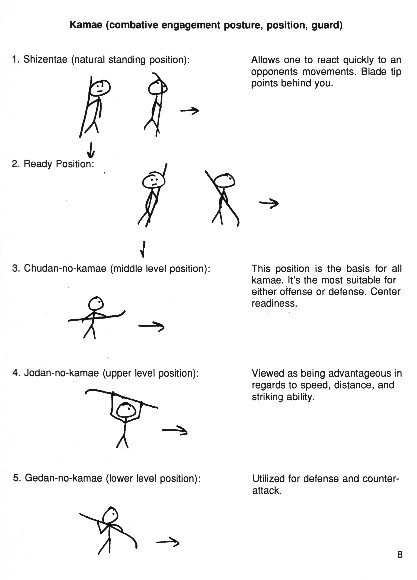
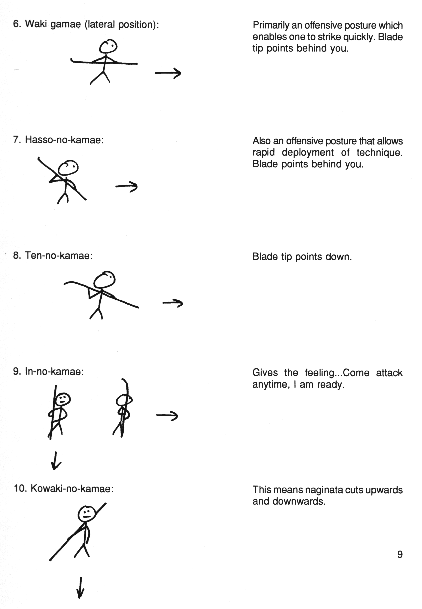
Footwork is involved when moving the body and when striking. One should
try to walk with the hips as the center of the body. Movement should cause
no sway in the upper body.
1. Okuri ashi (sliding step): For use when striking and is the basis
for moving in all directions. Lead foot
moves forward, the back foot slides
up.
2. Iumi ashi (walking step): Allows you to move backwards and
forwards.
3. Hara kioshi (side step): This is used when avoiding a strike or
responding.
4. Fumi kioshi: Used for changing the direction the
body is facing, on the spot, when
striking or responding.
5. Tsugi ashi: Used when striking from a distance or
when you want to take proper
distance quickly. (Shift the weight to
the back foot and skip or vice versa.)
Furiage (overhead windup) - Start position, chudan-no-kamae.
1. Furiage men uchi: Strike to center of forehead.
2. Furiage sune uchi: Strike to the shin.
3. Furiage kale uchi: Strike to the wrist.
Mochikae (overhead and to one side) - Start position, hasso-no-kamae.
1. Mochikae soku men uchi: Impacts the head just slightly to
the right or left of center.
2. Mochikae sune uchi: Impacts the wrist.
3. Cho uchi: Start position, waki gamae; Horizontal
strike to the center of the body.
Furikaeshi -Start position, chudan-no-kamae; One must keep the blade facing
down, change the grip above the head, and bring the naginata down
to strike.
1. Furikaeshi men uchi: Strike to the head.
2. Furikaeshi kote uchi: Strike to the wrist.
3. Furikaeshi sune uchi: Strike to the shin.
Tsuki: Start position, chudan-no-kamae. Thrust to the throat.
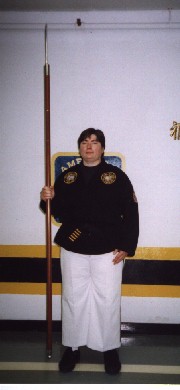

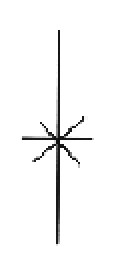
The form is executed by moving counter-clockwise in 45 degree increments.
The naginata-ka is the
calm, the Eye of the Storm. The storm, the carnage surrounding the
naginata-ka, does not disturb
the calm unless he allows it to.
Some of you have probably heard Master Shean say, that when you are free
sparring, it should be
done as if you were another person outside of yourself watching both you
and your opponent. When
that happens, you are the calm; You are impartial with no emotion.
NOTE: Kihaps in form denoted by (*).
FOOTNOTES
Return to Traditional Martial Arts Weapons
